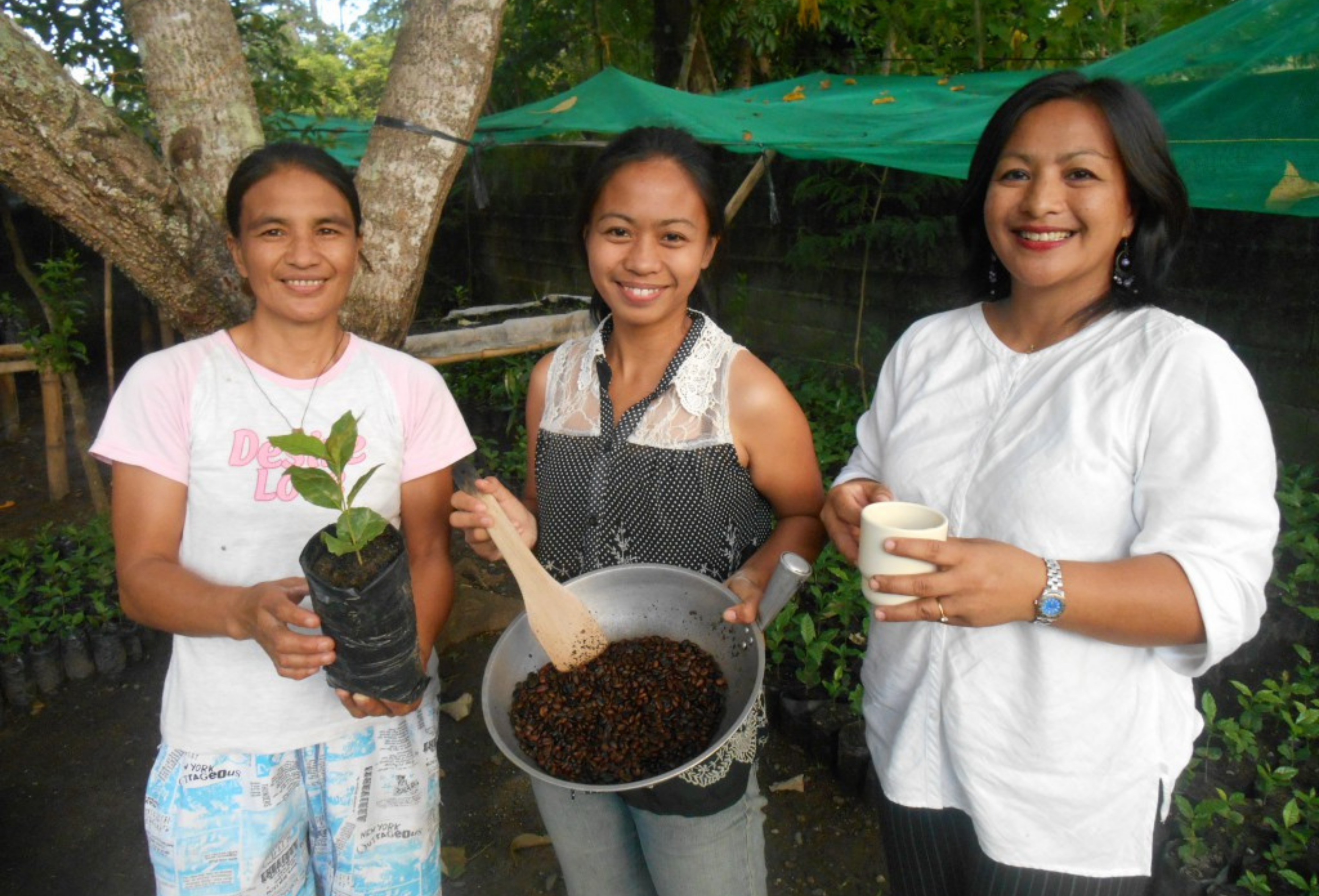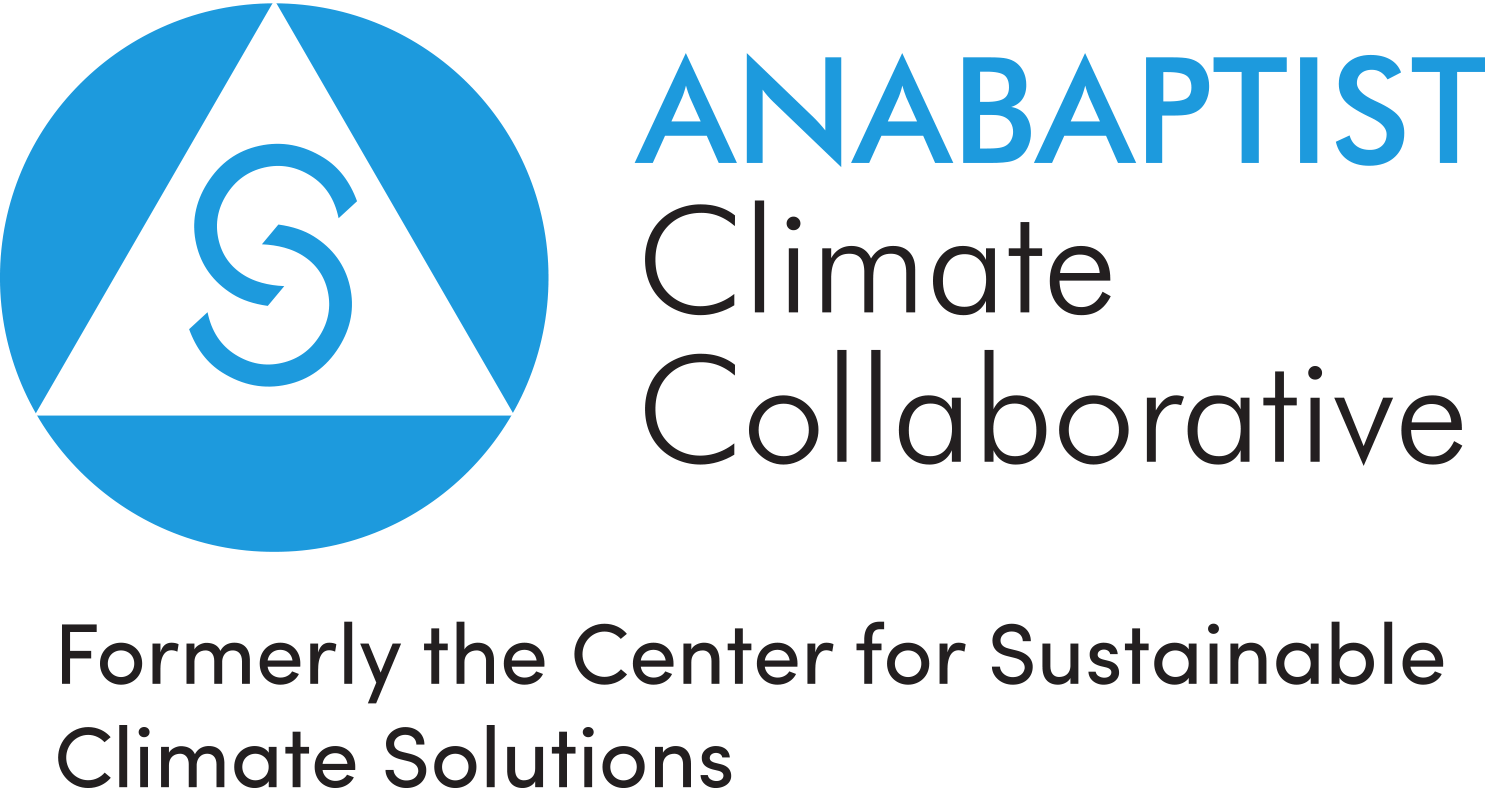Peacebuilding Through Coffee Farming
a story from Sumacher
Even over Zoom, Tala Bautista exudes a warm and joyful presence – an impressive feat. I had the chance to talk with Tala about her summer research for the Center for Justice and Peacebuilding at Eastern Mennonite University, where she is a graduate student. The Center of Sustainable Climate Solutions had the honor of funding part of her “student research assistantship,” which focused on the interplay between Peacebuilders Community Inc (PCBI) and Coffee for Peace (CFP), where she is Senior Vice President. PCBI is a Mennonite peacebuilding organization in the Philippines which also focuses on reconciliation, justice, and development. During their work, they were often met with the question, “how can we talk about peace if our stomachs are hungry?”

Tala Bautista (center), with Letty Alngag and Malou Alngag, show some of the stages of coffee processing.
“Out of that need articulated by the people,” Tala explained, “Coffee for Peace was born. PBCI trains the farmers, and CFP buys the coffee at a fair-trade price.” The title of Tala’s research, “Evaluation and Creation of a Plan to Improve the Ecological Sustainability of Coffee for Peace,” indicates the need for increased environmental sustainability practices in the coffee shop and processing plant. However, Coffee for Peace also addresses large-scale environmental degradation issues in the Philippines. “Aside from addressing the economic need, coffee also addresses the issue of forest denudation due to logging and monocropping. Coffee needs trees and other plants to improve its quality. With this, coffee encourages farmers to reforest and practice multi-cropping, which in turn increases economic returns.” Moreover, coffee is offered at every home in the Phillippines: Muslim, Christian, Indigenous – coffee is a staple regardless. It is here that I began to recognize the intersectionality of Tala’s work.
Already, Tala’s research piqued my interest, yet her personal story is equally fascinating. Growing up in the Indigenous community, Sumacher, she explains that this facet of her identity has impacted her in a variety of ways. In her history classes in school, there was no mention of the indigenous peoples in the Philippines and their role in the nation’s history. She felt invisible. Yet discrimination was also rampant, often being refused apartments due to her ethnicity and stereotypes that her people were savages and “headhunters.” So when Tala went to university (at the age of 15!), she had many questions. It was here that she was introduced to Marxism and Leninism by fellow students and was taught to see the Philippines’ history through this lens. For the first time, the dissonance she felt as a child between her indigenous identity and Filipino identity was explained through Marxist ideas. The students described the details of the classist struggle and the need to make the “triangle into a square.”
Upon hearing this, Tala asked how this transition would take place. Eventually, it was revealed that the only way would be through armed revolution. This was deeply concerning to Tala. “In my culture, if you eat with someone, you cannot then go on to harm them,” she explained. “And in the cafeteria at university, I was eating with a girl who was part of the one percent rich – does this mean I have to kill her? I can’t do that.” Tala agreed with the problems that the Marxist students described and that the triangle, indeed, should become a square, but she didn’t agree with the methods. It was then she began to learn more about faith and Christianity. From a young age, she knew always wanted to serve God and people, but she only learned about God as holy. During her time in university and in experiential ways, she began to learn about God as more than just holy – He is also grace and love and mercy.
 During this time, at the age of 19, Tala began working for the Philippine government and witnessed first-hand the rampant and intense corruption. It bothered her in many ways and left her with nightmares. She eventually resigned from her governmental work and then met a Catholic bishop who helped deepen her Indigenous worldview. One question, however, kept bothering her: “After we accept Jesus, do we just have to wait for heaven to get love, grace, and mercy?” This question marinated in her mind as she began to do peace-building work and started finding ways of enacting love and grace on earth – not just in heaven. “Peace is harmony with the Creator,” Tala told me, “and is a spiritual transformation. Harmony with the being is a psycho-social transformation, harmony with others is a socio-political transformation, and harmony with creation is an economic-ecological transformation.”
During this time, at the age of 19, Tala began working for the Philippine government and witnessed first-hand the rampant and intense corruption. It bothered her in many ways and left her with nightmares. She eventually resigned from her governmental work and then met a Catholic bishop who helped deepen her Indigenous worldview. One question, however, kept bothering her: “After we accept Jesus, do we just have to wait for heaven to get love, grace, and mercy?” This question marinated in her mind as she began to do peace-building work and started finding ways of enacting love and grace on earth – not just in heaven. “Peace is harmony with the Creator,” Tala told me, “and is a spiritual transformation. Harmony with the being is a psycho-social transformation, harmony with others is a socio-political transformation, and harmony with creation is an economic-ecological transformation.”
The keyword here is transformation. Tala recognized the reality that socially, politically, environmentally, and spiritually something is very wrong. Peace requires a transformation, thus peace-building must create spaces, avenues, and resources for these transformations to take place. In her work with Coffee for Peace, Tala is beginning to focus on harmony with Creation as a form of environmental justice and peacebuilding. She constantly looks for areas to improve and continues to ask the question: “Are we practicing harmony and peace with creation in our organization? And can we do it better?” We are so grateful for Tala’s important and transformational work and research, as well as her example of faith-filled, bold, and attentive living.
It was such a joy to listen to Tala’s story (she is an incredible storyteller!) and to discover the threads of empathy weaving throughout her powerful narrative. So, dear reader, I ask you, what is your story? What are you passionate about and why? What stories do we tell ourselves and how do these stories influence us? What are the stories around you that are being ignored or disregarded? How can you amplify and learn from those stories? There is power in the stories we hold and the narratives we tell, Tala has shown us that.
Article written by Judith Marklin
Communications Consultant

